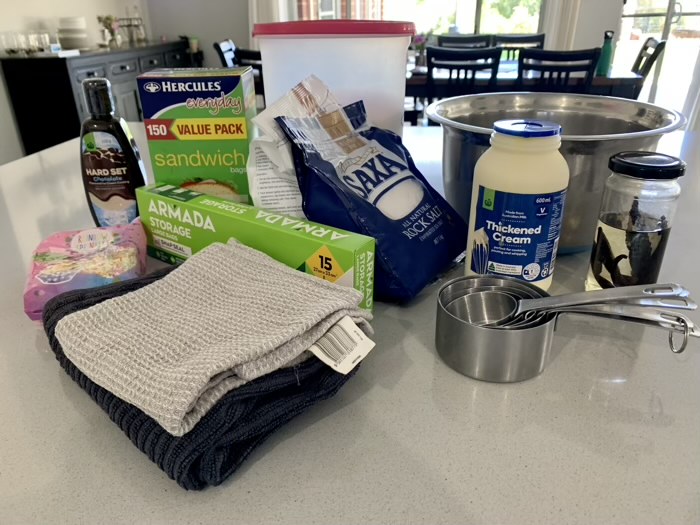My girls love their ice-cream and so combining science learning with the making and eating of ice cream was a hit. They are aged 9 and 11, but we will be undertaking this particular science experiment in addition with a little one aged 5 and a bigger boy aged 12. The lesson can be adapted accordingly.
Firstly, some of the key understandings that can be explored:
- temperature and freezing points (and that they can vary for different matter)
- states and phases of matter
- the chemical make up of water & salt
- emulsions
- mixtures
Key terminology to understand and learn:
temperature – thermometer – Celcius – Fahrenheit – freezing point – matter
chemical reaction – variables – emulsion
Equipment needed:
- sandwich ziplock bags
- large zip lock bags
- ice
- rock salt
- sugar
- vanilla extract
- cream
- milk
- ice cream toppings
There are three aspects to this lesson:
- Reviewing or introducing the states of water and discussing what a thermometer does and its unit of measurement. This step will vary depending on what your children already know. Could do a brainstorm around states of water, throwing in some prompts to help).
- Undertaking the experiment and making ice cream. Follow the instructions and ask inquiring questions along the way.
- Varying the experiment to assist with understanding the chemical reaction of salt.
Additionally, further questions may come up and give opportunity for extending the learning.
The experiment:
- First mix 2 lots of the following: 1/4 cup of milk with 1/4 cup of cream. Set aside.
- Then add to each of the sandwich ziplock bags: one tablespoon of sugar, the mixed milk and cream and 1/4 teaspoon of vanilla extract. Seal the bags well. Set one of these bags aside for Part B.
Part A
- Add four cups of ice cubes to one of the large zip lock bags. Then add 1/2 cup of salt to the large bag.
- Put one of the small ziplock bags into the large bag with the ice cubes and salt mixture. Remove air from the bag and seal the larger bag. Q: What do you think adding the salt will do? Why?
- Wrap the bag in a small towel and then shake the bag for five minutes (It may take a little longer). This would be a good time to measure the temperature of the mixture and record it. Q: What happens to the ingredients? When five minutes are up, how do the ingredients look? Do the ice cubes look the same or do they look different? Why do you think this is?
- Enjoy eating the ice cream! We put the ice cream into bowls and had some of the salt end up in the bowls (try to avoid that). You may like to add sprinkles and other toppings.
Part B
- Now add four cups of ice cubes to the other large ziplock bag. Do NOT add salt this time. Q: What do you think will happen without using salt? Why?
- Put the other small ziplock bag with the prepared ingredients into the large bag. Remove the air from the bag and seal the bag.
- Wrap bag 2 in a small towel and shake the bag for five minutes. Again, feel the smaller bag every couple of minutes and take a peek at it. Again, measure the temperature of this mixture and record it. Q: What happens to the ingredients? When five minutes are up, how do the ingredients look? Do the ice cubes look the same or do they look different? Why?
- Compare the temperature of both mixtures. Discuss results.
- The failed ice cream mixture can be corrected by adding salt to the ice and shaking the bag for about 5 min. Once it is harder, enjoy!
Extension:
- Switch up ingredients: use milk or heavy cream to make the ice cream. Explore the results.
- Explore emulsions, which we plan to do.
- Explore freezing points of various liquids. Record these in a chart.
Basic observations:
- Salt allows the ice and salt mixture to get colder than just water ice.
- Water freezes at 0 degrees Celsius
- Water mixed with salt will freeze below 0 degrees Celsius
Other helpful links
Understanding Temperature (includes a video link ‘Reading a Thermometer’)
What’s Matter ? Better for older children.
States of Matter for kids (Better for little ones)
Freezing Point A bit of a silly one to begin some experimentation with freezing

